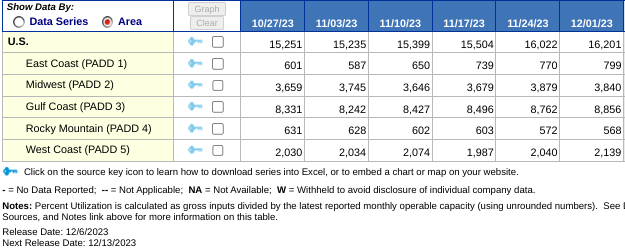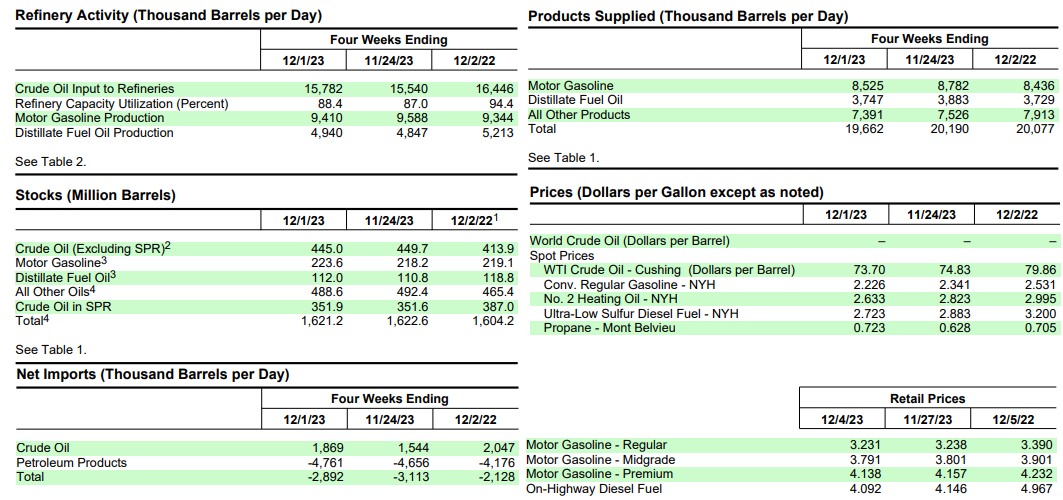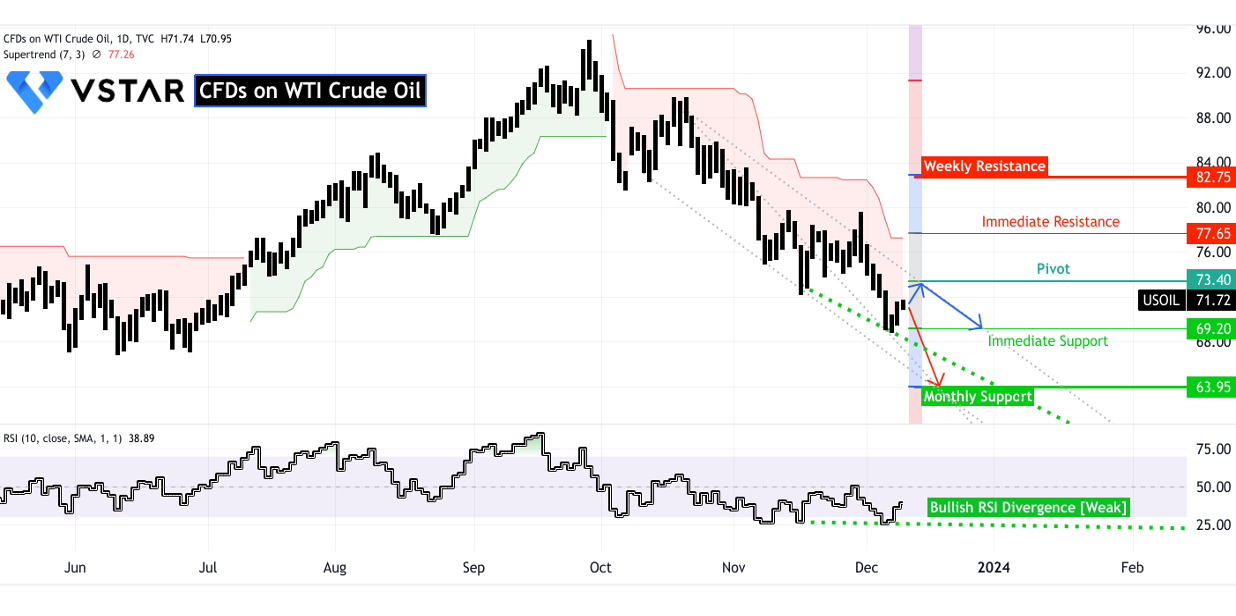In the crude oil market, a dynamic interplay of supply, demand, and market intricacies paints a landscape ripe with fluctuating possibilities. Recent EIA data unveils crucial insights into refinery operations, inventory levels, and price movements, signaling potential shifts in the intricate world of commodities. Understanding these nuances is pivotal in deciphering the future trajectory of CFDs on Crude Oil.
- Refinery Operations & Production: Increased refinery inputs and rising gasoline/distillate production hint at heightened demand for crude processing.
- Imports & Inventories: Surge in crude oil imports alongside decreased inventories slightly below the five-year average suggest balanced but sensitive supply dynamics.
- Petroleum Inventories & Product Supply: Imbalance in gasoline/distillate inventories versus their five-year averages may impact crude oil price volatility.
- Price Movements: Declining crude oil, gasoline, and diesel prices indicate market adjustments influenced by potential oversupply or reduced demand.
Interpretation of EIA Data
Refinery Operations and Production
Crude Inputs & Capacity:
Refinery inputs increased marginally to 16.2 million barrels per day during the week ending December 1, 2023. This uptick of 179 thousand barrels per day from the previous week suggests a slight surge in demand for crude processing. Refineries operated at 90.5% of their operable capacity, signifying an active utilization of resources to meet the rising demand for refined products.

Source: eia.gov
Gasoline & Distillate Production:
Both gasoline and distillate fuel production experienced an increase last week, averaging 9.5 million barrels per day and 5.1 million barrels per day, respectively. This production rise indicates potential growth in consumer demand for these refined products or an anticipation of higher consumption, possibly due to seasonal variations or economic activities.
Crude Oil Imports and Inventories
Imports:
U.S. crude oil imports spiked to an average of 7.5 million barrels per day last week, marking an increase of 1.7 million barrels per day from the previous week. This surge in imports points toward a need to supplement domestic supply to meet the demand or address a shortfall in existing inventory levels.
Inventories:
Commercial crude oil inventories decreased by 4.6 million barrels from the previous week, indicating a drawdown in stockpiles. However, despite the reduction, the inventories remain approximately 1% below the five-year average for this time of year. Gasoline inventories observed a notable increase by 5.4 million barrels, yet they are about 1% below the five-year average. Distillate fuel inventories, although rising by 1.3 million barrels, are about 13% below the five-year average.
Petroleum Inventories and Product Supply
Gasoline & Distillate Inventories:
While gasoline inventories increased, distillate fuel inventories remained notably below the five-year average. This imbalance could potentially signify a stronger demand or supply chain disruptions in the distillate fuel segment, impacting future pricing dynamics.
Total Commercial Petroleum Inventories:
Total commercial petroleum inventories showed a decrease by 1.7 million barrels last week. This decline, albeit moderate, suggests a potential tightening in the overall petroleum supply situation, which could influence market sentiment and price fluctuations.
Total Products Supplied:
Total products supplied over the last four-week period averaged 19.7 million barrels a day, reflecting a decrease of 2.1% from the same period last year. However, specific segments like motor gasoline product supplied exhibited a slight increase of 1.1% compared to the same period last year. These variations in product supplied indicate shifts in consumer behavior or economic activities, impacting demand and, subsequently, CFD prices for crude oil.
Price Movements
Crude Oil Price:
The West Texas Intermediate (WTI) crude oil price dropped to $73.70 per barrel on December 1, 2023, marking a decrease of $1.13 from the previous week and $6.16 lower than the price observed a year ago. This decline in price could be attributed to various factors such as market sentiment, geopolitical tensions, supply-demand dynamics, and global economic conditions, impacting CFD prices for crude oil.

Source: eia.gov
Gasoline & Diesel Prices:
Spot prices for gasoline and heating oil at New York Harbor decreased compared to the year-ago prices. The decline in these prices could suggest either an oversupply situation or weaker consumer demand, which might impact the future price direction of CFDs on crude oil.
National Retail Prices:
The national average retail price for regular gasoline declined to $3.231 per gallon on December 4, 2023. This decrease of $0.007 from the previous week and $0.152 below last year's price indicates potential shifts in consumer behavior or market dynamics that could influence the price trajectory of CFDs on crude oil.
Possible Implications on Price
Demand and Production Increase
The slight rise in refinery operations and increased production of gasoline and distillate fuel implies growing demand or anticipation of higher consumption. This could potentially exert upward pressure on CFD prices for crude oil due to the expected increased demand for raw crude material.
Imports and Inventory Levels
The notable increase in crude oil imports coupled with a decrease in commercial crude oil inventories suggests efforts to fulfill domestic demand or replenish inventory levels. Despite the inventory reduction, the levels remain slightly below the five-year average, indicating a balanced but potentially sensitive supply situation, impacting the price volatility of CFDs on crude oil.
Petroleum Inventories and Product Supply
The imbalance between gasoline and distillate fuel inventories concerning their five-year averages might lead to fluctuations in CFD prices for crude oil due to perceived supply tightness. The decrease in total commercial petroleum inventories could further influence market sentiments and price movements.
Price Movements and Consumer Trends
The declining prices of crude oil, gasoline, and diesel suggest potential market adjustments aligned with either oversupply or reduced demand. These price movements might exert downward pressure on CFD prices for crude oil in the short term due to market perceptions and consumer behaviors impacting future demand forecasts.
Crude Oil CFDs: Technical Take
CFD prices for Crude oil, finding a foothold at $69.20, appear poised for a period of relative stability. The Relative Strength Index (RSI) indicates a slight uptick following a bullish divergence last week, although it presents with weak intensity. Anticipating an upward move (blue path) toward the $73.40 pivot point, there's potential for retesting the key support at $69.20, signaling sideways movement.

Source: tradingview.com
However, downside risks loom, with a probable decline to $63.95 (red path) if demand fails to counter the increased supply. Despite this, the augmented imports and reduced inventory levels mitigate further downside potential.
In conclusion, the data suggests a mixed scenario with some indicators pointing towards increased demand and consumption (refinery operations, production), while others reflect potential concerns (inventory levels, product supply decreases).




